Home » Jazz Articles » Live Review » Norwegian Road Trip, Part 6: Molde Jazz, Days 3-4
Norwegian Road Trip, Part 6: Molde Jazz, Days 3-4
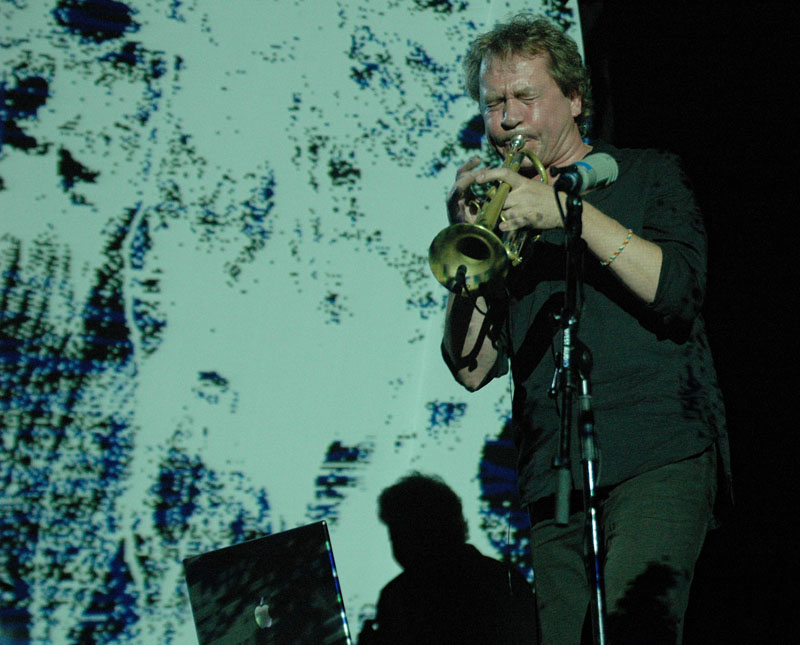
[Editors Note: From July 6 to July 26, 2010, All About Jazz Managing Editor John Kelman will travel throughout Norway to cover both the Kongsberg Jazz Festival (also participating in Silver City Sounds) and Molde Jazz. He'll also spend a week between the two famous festivals in Oslo, where he'll check out the scene, talk to musicians and labels, and visit the legendary Rainbow Studio for a look around and an interview with engineer Jan Erik Kongshaug, who has participated in hundreds of ECM recordings. He'll publish every second or third day, so be sure to follow him as he goes from the east coast to the west, in search of Norwegian artists known and unknown].
With Molde Jazz celebrating its 50th Anniversary in 2010, there are even more special projects than usual, and an even richer roster than at the 2009 edition. The festival has long been host to special projects and, as one of five festivals—Molde being the only jazz event—receiving additional government funding, Molde has been able to commission new works that have been recorded and ultimately released commercially. The festival has also been a part of the Intro Jazz: Årets Unge Jazzmusikere program, where eight groups are selected each year, from a larger collection of applicants, to compete for a prize of several hundred thousand Norwegian Kroners that can be used to help further their careers. The competition began in Kongsberg, just a couple weeks prior, where eight groups were trimmed down to four.
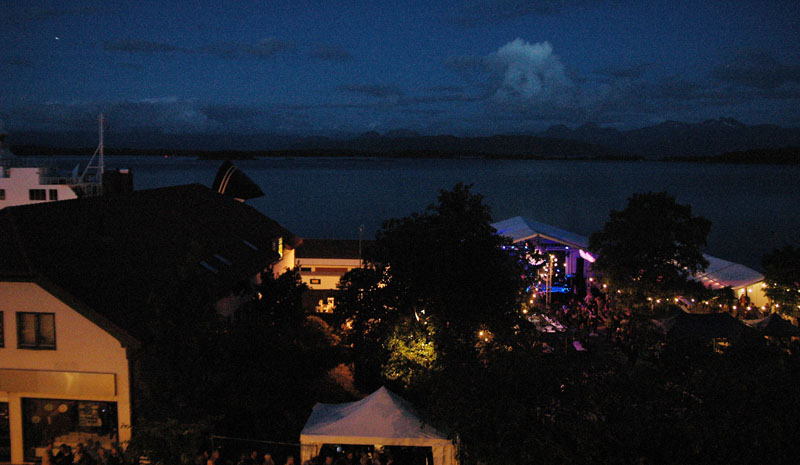 Molde, at 1:30AM
Molde, at 1:30AM The four finalists competed at Molde, and the winner turned out to be the duo of guitarist Per Arne Ferne and pianist Per Gunnar Juliusson—a fine choice, as their set in Kongsberg was a combination of appealingly writing and empathic interplay. Ferne and Juliusson were enjoying their win in the Molde Jazz press center during the afternoon of July 21, and were also busy participating in interviews with journalists and a radio broadcast by NRK, from Alexandra Park later that day.
Sadly, the weather in Molde was not as fine as it was in 2009, with clouds settling in the first day of the festival and near-constant rain creating some problems for the festival's outdoor shows. Still, the sun may not have been shining but there was plenty of warmth to go around, as audiences were treated to a fantastic program that combined the best of international jazz with equally impressive Norwegian groups— some well-established, others new and on an upward trajectory. Certainly no amount of inclement weather could stop two of the festival's best performances thus far from taking place during the evening of July 21.
Chapter Index
- July 21: Ketil Bjørnstad's Antonioni Project
- July 21: Nils Petter Molvær Trio
- July 22: Ola Kvernberg's "Liarbird," with Joshua Redman
- July 22: Puma
July 21: Ketil Bjørnstad's Antonioni Project
Sometimes everything works out exactly as planned. When pianist Ketil Bjørnstad spoke with ECM label head/producer Manfred Eicher about putting together a group for his proposed project, an homage to Italian filmmaker Michelangelo Antonioni, not only was the line-up decided in a single minute, but everyone on Bjørnstad and Eicher's collaborative "A" list was actually available: bassist Arild Andersen, cellist Anja Lechner, saxophonist Andy Sheppard, guitarist Eivind Aarset and percussionist Marilyn Mazur. Bjørnstad has worked with most of these players before in other contexts—noting enthusiastically, after the ensemble's absolutely stunning performance, that with each member a part of the larger ECM family, the show also demonstrated the remarkable breadth of the label's stylistic purview. What it also proved was just how well these musicians—from a broad range of personal stylistic endeavors—could come together to create music that was filled with grace, passion, beauty...and power. Speaking with a single voice, and filtered through Bjørnstad's musical prism, to be sure; but equally, never sounding like anyone other than themselves throughout their 80-minute performance at Bjørnsenhuset.
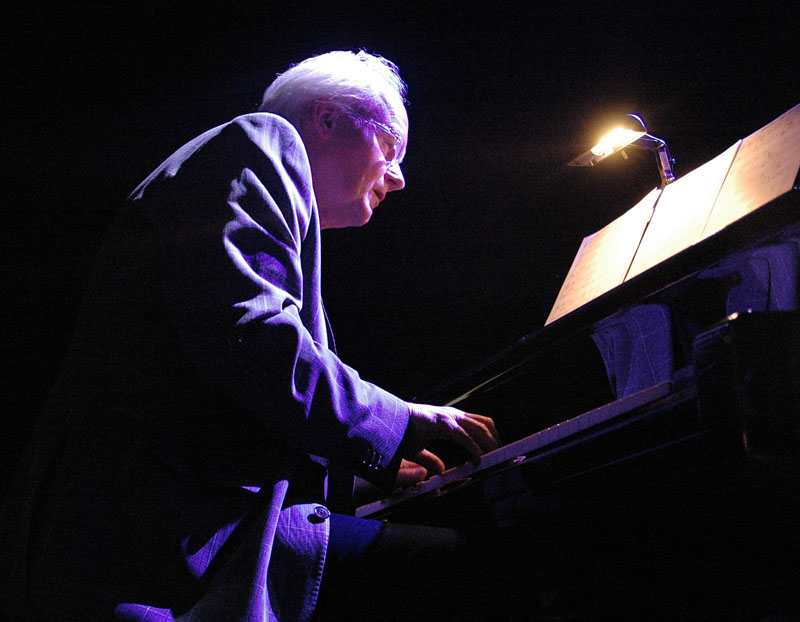
Introducing the performance to his audience, Bjørnstad spoke of ECM's long historical affiliation with film, and recent musical tributes including French pianist Francois Couturier's Nostalghia—Song for Tarkovsky (2006). Setting the mood for the performance, he left the audience with a few thought-provoking quotes, before returning to the piano:
Everything in life gives you insight. —Ketil Bjørnstad
Film is a petrified fountain of thought. —Antonioni"
I don't want to describe what I saw; I want to describe what I felt when I saw it. —Edvard Munch
Beginning with Mazur's deep gongs—so quiet that they commanded the audience's attention far more profoundly than had they been more overtly dramatic— Bjørnstad and the ensemble wound its way through a suite of twelve untitled pieces; most connecting seamlessly, though there were a couple of brief breaks—just enough time for the enthusiastic applause that continued to build as the performance continued.
Bjørnstad's music has always been a logical outgrowth of his classical background and training, but he's also worked with colors that are rarely heard, even in the neoclassical world; most specifically the soaring and sometimes searing guitar work of Terje Rypdal—who has participated on a number of the pianist's ECM releases including Life in Leipzig (ECM, 2008). Aarset's contributions to non-ECM albums including Before the Light (Universal Music Norway, 2001) have been sonically broader still; in performance, applying warm soundscapes, densely jagged electronic textures and even some twangy, tremelo'd surf-like guitar on the evening's final piece. Aarset's sonic choices were always perfect; more remarkable, still, that they were being made on the fly, with his usual mad scientist's rig of pedals and laptop. It's rare to hear Aarset perform on anything but his customized electric guitar, but early in the set he brought out a gorgeous sounding steel-string acoustic that, at times, possessed the surprising warmth and organic feel of a nylon-stringed classical guitar.
 P
P It was also a rare opportunity to hear Aarset performing with a more decidedly guitaristic bent; sometimes mirroring Bjørnstad's lyrical melodies, other times doubling Andersen's powerful bass lines. Andersen was, as ever, a powerful anchor at the low end of the sound spectrum, but was also an engaging melodic foil for Bjørnstad, Sheppard and Lechner. Most impressive was an early improvisational segment, beginning with Bjørnstad and Lechner pairing in spontaneous melodism, but then moving to a more energized duet between the cellist and Andersen—Lechner playing arco, while the bassist layered lightning fast but always thematically focused pizzicato lines.
Mazur then took over for Lechner, and turned the temperature up even further in duet with Andersen. That Mazur appeared to have complete and utter command of her massive percussion rig was belied by a conversation after the performance, where she explained that, many times, her working with percussion instruments provided by festivals allows for the sound of surprise that gives her playing such marvelous unpredictability, unfailing power, and delicate strength. And she'd not have it any other way.
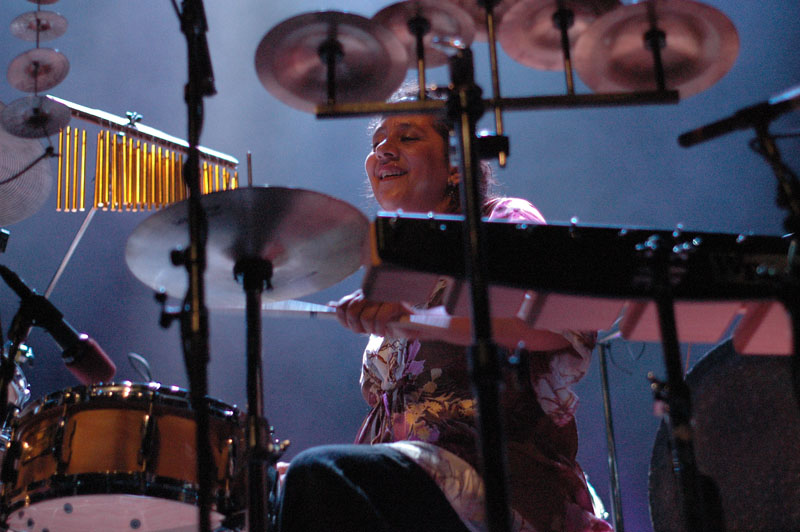 Marilyn Mazur
Marilyn Mazur There's a compelling physicality about the way that Mazur approaches her instruments—drum kit, gongs, bells, wood blocks, gourds, a huge bass drum and more. It's made her a unique percussion voice in the jazz world, able to groove and swing with the best of them, but with an infusion of ethnic percussion and a lifetime study of rhythms throughout the world that have turned her into a player as comfortable with the fusion of Miles Davis in the 1980s and the world music-centric albums of Jan Garbarek in the 1990s, all leading to her own discography with groups including the cross-cultural and forward-thinking Future Songs, and a more recent improvised duo record with Garbarek, Elixir (ECM, 2008).
Sheppard is relatively new to ECM as a leader, releasing Movements in Colour in 2009, but he's familiar to fans of Carla Bley for his longstanding relationship, heard most recently on the pianist's smaller group recording, The Lost Chords Find Paolo Fresu (WATT/ECM, 2007). Here, in the context of Bjørnstad's new score, he contributed a vital combination of gentle lyricism on soprano, and visceral power on tenor, as he moved from deep, almost growling phrases to soaring screams in the upper register. A tenor solo late in the set engendered a resonant group energy, with Andersen, Lechner and Bjørnstad smiling amongst one another as they pushed and pulled with his pliant lines, creating an unexpected and sheer in-the-moment excitement rarely heard from the pianist—not, at least, on record.

It was that very dynamism that made the performance so special. Bjørnstad is known for his compelling writing, the kind of music that's as much a spiritual journey as it is a sonic one. And being a published poet and writer of both fiction and non-fiction- -sometimes blurring the two on his The Story of Edvard Munch (Arcadia, 1993), or embedding the autobiographical within the fictional on To Music (MAIA, 2004)—it's no surprise that his music often possesses a strong narrative arc, despite often being without words, as was the case with his "Antonioni Project." Bjørnstad combined the familiar and the new: familiar, in the kinds of serpentine yet singable melodies he has always written; new, in the breadth of dynamic of a performance that ranged from near-silence to thunderous power and maelstrom-like turbulence, as Mazur, in particular, propelled the group with effortless energy and intuitive color. The pacing of the set couldn't have been better either, with each leap into exhilarating dramatism matched by subtler interludes, including a soft, poignant piano solo, mid-set, that was written for one of Norway's biggest musical advocates, England's Fiona Talkington, of BBC Radio 3.
As the set drew to a close, there was a tangible sense, from both Bjørnstad's group and the audience, of coming to the end of a long journey, a feeling of returning home. That this group had only two rehearsals before it hit the stage was impressive; that it didn't demonstrate any of the nervous energy of a first-time performance even more so. While Mazur confirmed this feeling in conversation after the show, it wasn't actually necessary; there was a constant and palpable sense of comfort, togetherness and trust that made Bjørnstad's "Antonioni Project" not just one of the best shows of Molde 2010, or one of the best projects in the pianist's long career. It was, quite simply, one of the most profoundly moving performances in recent memory; a show that touched on a myriad of feelings and images—perfect, then, in its homage to the great Italian film director.
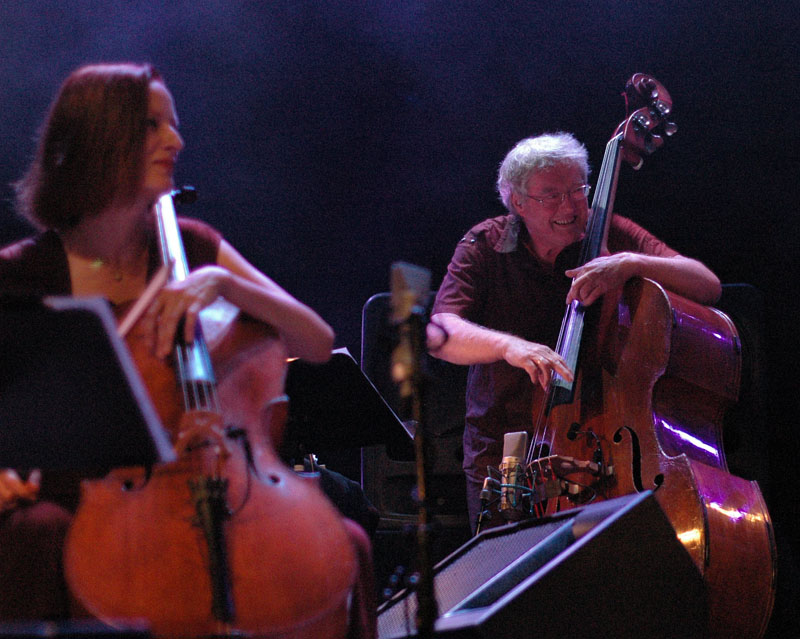
That the performance—which sounded terrific throughout the hall, but most impressively even in the very front row, where the sound of the room is often lost amidst music coming directly from the stage—was being recorded for future release by ECM was very good news. But while the album will, no doubt, be a terrific one—perhaps, even, the best recording of Bjørnstad's career—it will be no small challenge to replicate the feeling of having been there, making it incredibly good fortune for each and every member of the nearly full house to have been in this very specific place, at this very particular point in time. While there was no encore material for the group to play, that didn't stop the audience from giving it a well-deserved standing ovation, continuing thunderous applause long after the group had left the stage.
July 21: Nils Petter Molvær Trio
It's been a year since Eivind Aarset left trumpeter Nils Petter Molvær's regular trio—the combination of an increasing problem with tinnitus and a desire to spend more time at home, working on his own projects. With such a long history together—dating right back to Molvær's groundbreaking and seminal Khmer (ECM, 1997)—finding a replacement might have been a challenge, were it not for guitarist Stian Westerhus' return to Norway after a few years studying and playing in London. The guitarist was already creating considerable buzz for his work in Monolithic and Puma, but when Molvær rang Westerhus up, while the guitarist was on tour in Italy, the most important expectation was that he would bring his own voice to the trio, and not try to fill Aarset's inestimably large shoes.

Molvær, this year's Artist in Residence at Molde Jazz, brought his trio to Kulturhuset Klubb at midnight (seemingly, the trumpeter's preferred time to perform) and, while there were some familiar tunes amongst a set that was weighted heavily towards improvisation, as Westerhus described in an interview the previous week in Oslo, ..." the old stuff doesn't sound anything like the old stuff." Truer words were never spoken, with "Sabkah," from Molvær's most recent release, Hamada (Sula, 2009), retaining some of the song's gentle lyricism. But while Westerhus generally respected the song's Morricone- esque vibe, he also brought a darker challenge to the song, not, as he also described in Oslo, doing "Nils Petter as many musical favors." In fact, if anything best describes the new Nils Petter Molvær Trio, it's these words, also courtesy of Westerhus: "I can force Nils Petter into any corner I want, and he can force me into any corner he wants, which is great."
The set began in the darkness so typical of Molvær performances—with back projection lighting and processed live webcam imagery courtesy of longtime Light Designer Tord Knutsen—it quickly traveled to more jagged and angular territory, with Westerhus on his Dan Electro baritone electric guitar, fed through four amplifiers and an array of foot pedals. Westerhus—whose solo performance at Natt Jazz confirmed the unorthodox techniques he employs on his recent solo disc, Pitch Black Star Spangled (Rune Grammofon, 2010)—began grinding out grungy, distorted, low-end chords that resembled, at times, nothing more than visceral, gut-punching sound rather than any kind of harmonic center.

Molvær—whose playing at the opening show for Molde 2010 was its absolute highlight—extended the extremes from that performance even further—still capable of a personal sense of melodism that made distinctive use of constantly shifting harmonizing but, both encouraged by Westerhus and liberated by the guitarist to find his own new areas of screaming intensity that, in turn, pushed Westerhus to the edge of the precipice...and, occasionally, right over it. It was a whole new kind of dynamic and one where the eye contact between the two was a palpable presence, even when the lighting was so abstract that their faces could only be made out in passing.
But Molvær's trio performance at Molde was notable for more than just the opportunity to experience the new but already deep connection with Westerhus; with regular drummer Audun Kleive unable to come, Molvær recruited Erland Dahlen, last heard at Natt Jazz in May as the thundering presence behind both Eivind Aarset and his Sonic Codex group, and trumpeter Mathias Eick who, like Aarset, was debuting new material, thanks to that festival's commission. Dahlen also brought his saw to Molvær's show, contributing some otherworldly melodies as he bowed it mid-way during the set, during one of its mellower moments. But it was his cathartic drumming that, different than Kleive's but no less impressive, drove the trio towards new directions beyond those to which Molvær and Westerhus are clearly traveling each and every night. As the set drew to a close, Dahlen seemed to loosen up even further, pushing the trio hard, as Westerhus—back on his baritone after a short time on his Gibson hollow body electric— locked in with a staggered and staggering pulse, peppering the pulse with brief electronic wails, screams and walls of noise.
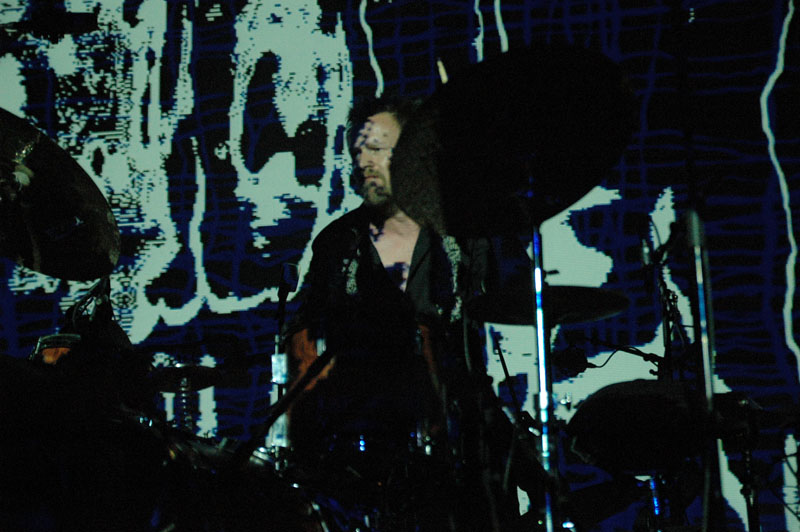
The pervading feeling throughout the trio's 90-minute set, was one of three players forming an equilateral triangle where it seemed as though each edge was constantly pushing—threatening, but never quite succeeding—at stretching into dominance. This constant push-and-pull and the trio's relentless give-and-take made the 90-minute set as exhilarating as it was dark, dangerous and aggressive.
Molvær's ability to handle shifts in personnel—while always retaining the ever-evolving stylistic voice that's placed him at the forefront of the Norwegian jazz scene—has never been as readily apparent or impressive as it was at his Molde Jazz 2010 performance, where a relatively new but fervently deep musical relationship with Westerhus was pushed even further with the wildcard of Dahlen—a player who, along with his band mates, is clearly someone to keep an eye on, and watch very closely at that.
July 22: Ola Kvernberg's "Liarbird," with Joshua Redman
One of the festival's most anticipated shows, violinist Ola Kvernberg's Kulturhuset performance—set up for standing only—was absolutely packed to the rafters. While it helps that Kvernberg is a local boy, coming from a small town nearby, that wasn't the only reason that a line-up went out of the venue and down the street before the show. Featuring a high-octane nonet—bassists Ole Morten Vågan (also playing acoustic guitar) and Ingebrigt Håker Flaten; saxophonists Hakon Kornstad and Joshua Redman; trumpeter Mathias Eick; drummers Erik Nylander and Torstein Lofthus; and violinist Bergmund Skaslien—there was more than enough star power to draw in not only fans of the violinist, but of his group's individual performers.
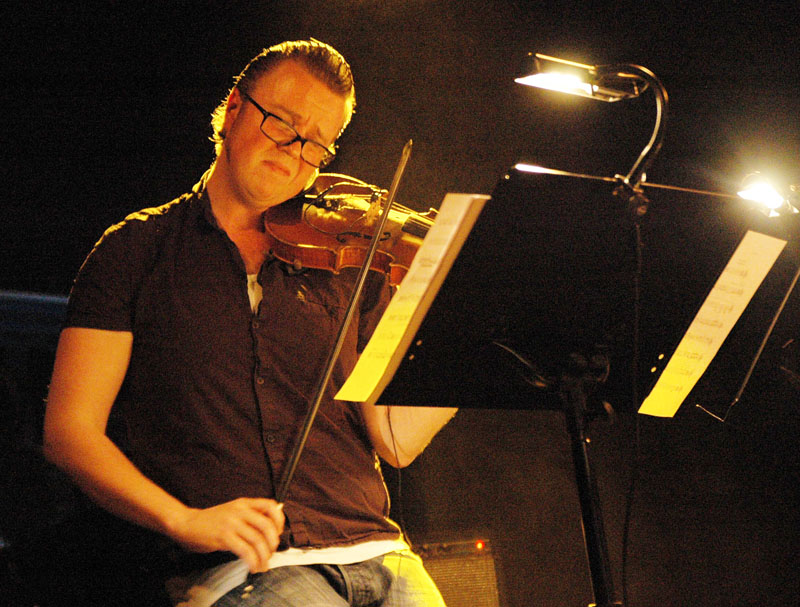
Kvernberg—whose Folk (Jazzland, 2009) was one of last year's most pleasant surprises—brought this new group together under the banner "Liarbird," with a 90-minute set of enthralling new music that gave everyone more than enough time in the spotlight, but also focused on the violinist's strong writing and ability to guide his band mates through its countless twists and turns. With only one break during the largely continuous, episodic performance, Kvernberg's suite touched on a variety of markers, including Norwegian traditionalism (folk music as well as brass bands); hints of Middle Eastern tonalities; wildly electric energy that wasn't exactly fusion, but somehow felt like it at times; detailed charts with shifting meters and wild harmonic excursions; and the kind of improvisational/interpretive freedom that took full advantage of this stunning group of players.
While Redman's appearance might have smacked of "ringer"—bringing in a well-known artist to elevate the potential popularity of the project—nothing could have been further from the truth. Redman—alternating between tenor and soprano—played his ass off, to be sure, but in this egalitarian situation, didn't shine any more than the rest of his band mates. Redman was, in fact, clearly engaged in the show and loving what he was hearing around him; in particular, during one of Kvernberg's best solos towards the end of the set, where the saxophonist seemed to be looking around him in amazement, hollering encouragement at the violinist, whose incendiary solo was bolstered even further by the sometimes thundering support of Nylander and Lofthus. As strong as Kvernberg's solo was, it was actually part of a longer segment that started with Eick, delivering one of the most lyrical features of the show, and then moved to Redman, Kvernberg and, finally, Kornstad for a breathtaking series of solos that provided some of the set's most memorable moments.
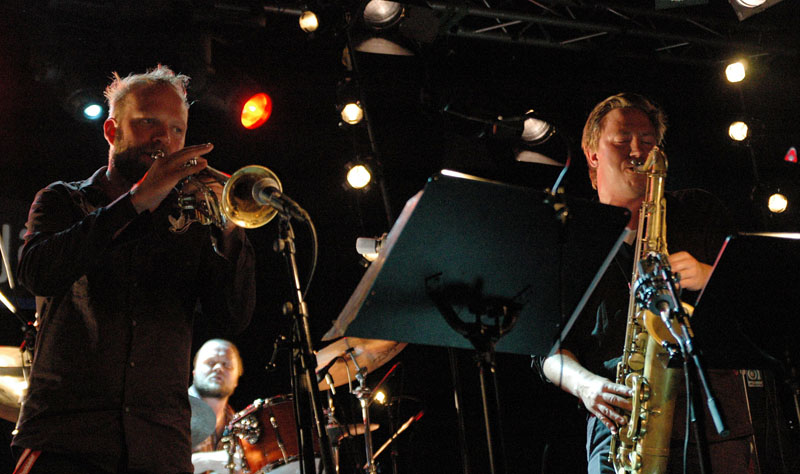
Kvernberg's Trio+1 performance at Natt Jazz 2009 was incendiary, but "Liarbird" went positively nuclear on more than one occasion, the audience screaming in approval throughout. Kvernberg, using two violins—a normal model as well as his octave violin, tuned an octave below the normal range—interacted with Skaslien, who was located on the far side of the stage; sometimes doubling lines, other times Kvernberg strumming his violin like a mandolin, while Skaslien stuck with a bow. With two bassists as powerful as Flaten and Vågan, when the music grooved, it grooved hard, all the more thanks to Nylander and Lofthus.
The group even proved that it's possible to dance in 5/4, as the audience moved to a lengthy passage, towards the end of the set, where the two drummers demonstrated remarkable telepathy. And when Kvernberg gave Nylander and Lofthus the chance for an in tandem solo near the end of the performance, it was a thrilling example of collaborative spirit within the context of a clearly structured context, made clear when Kvernberg began to tap his violin in time with some of the drummers' complex stops and starts. A lot of Norwegian groups are using two drummers these days—including Eick's own group and guitarist Eivind Aarset's Sonic Codex—but it's a credit to all these groups that the drummers never seem to get in each others' way, creating a broader percussive undercurrent and pushing the power of their groups with thundering, unshakable grooves when necessary.
Redman may be the most well-known of the group on an international level, but hearing him beside Kornstad, it was absolutely clear that the Norwegian innovator is working at the same high level, with his own harmonic sophistication, unerring virtuosity and knowledge of the jazz tradition. Kornstad also worked in some of his seamless technological integration, at one point building an expansive solo of layered loops, extended techniques and thoughtful lyricism not unlike the work on his most recent release, Dwell Time (Jazzland, 2009). From the smile on his face throughout the set, Kornstad was clearly enjoying the opportunity to work with Redman, but based on the American saxophonist's body language, it was obvious that he was having just as much fun—and, perhaps, learning just how strong the Norwegian scene is, first-hand.
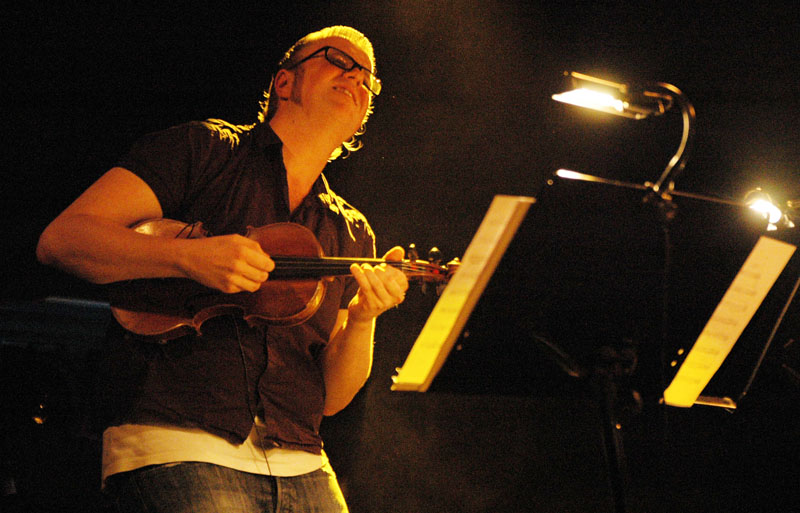
Kvernberg was equally enthralled by the entire group, directing it even as he got lost in the music. A recording of "Liarbird" will hopefully be following—and soon—but until then, the memory of yet another outstanding Molde Jazz 2010 performance will have to suffice.
July 22: Puma
In an interview in Oslo the previous week, guitarist Stian Westerhus described his latest album with post-rock free improvising group Puma—Half Nelson Courtship (Rune Grammofon, 2010)—as "more melodic than we've ever been." There were certainly undeniable moments of thematic construction during Puma's 90-minute set at the small but sold out Forum Kveld, as the usually completely improvised trio, for the first time, actually performed material from its album. There were moments of abstruse beauty, too; but beauty for Puma, not unlike Supersilent—an unmistakable touchstone for the group's exploration of sound's outer limits—is a significantly different beast.
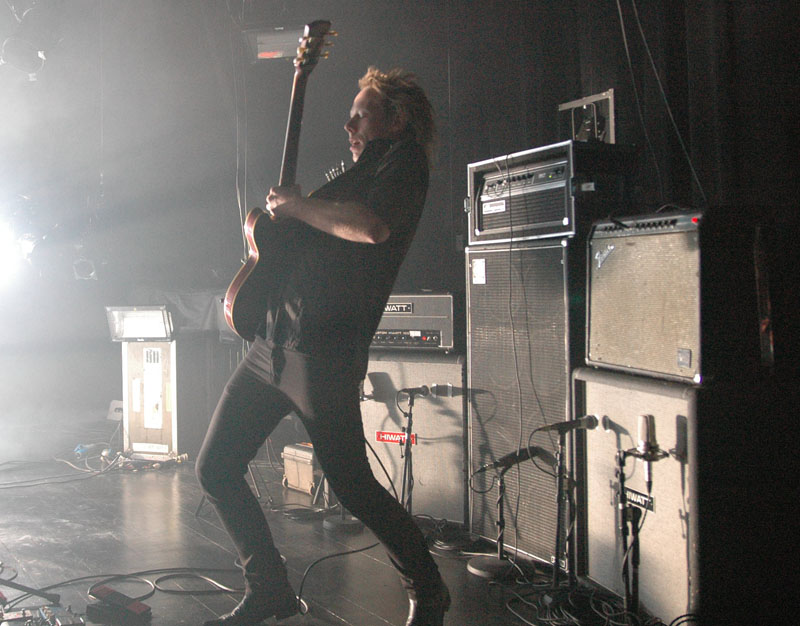
The spirit of Supersilent may continue to loom large over many groups that fall into the category of noise improv, but Puma has developed its own voice, with a combination of Øystein Moen's orchestral keys, drummer Gard Nilssen's blend of pulse and color, and guitarist Westerhus' intrepid unorthodoxy. Beginning in darkness, with smoke billowing from the back of the stage, Puma delivered a set that despite—or, perhaps more accurately, as a consequence of—its oblique and often aggressive nature, will go down as one of Molde Jazz 2010's best, if not one of the its best ever.
As prone to angular bursts of screaming, feedback-laden sonics as he was greater subtlety and surprisingly haunting beauty, Westerhus began the set by rapidly tapping his guitar pick against the strings of his guitar; broadening the soundscape with his wide array of effects pedals. That he was often able to adjust settings with the toe of his boot, or by quickly crouching down to use his hands—even as he appeared totally lost in the moment—was evidence of a player for whom these devices were a natural extension of his hands and his guitar.
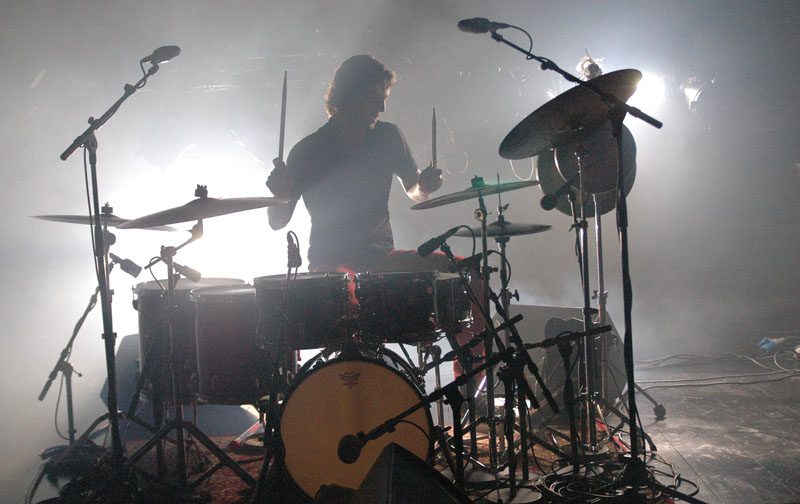
Visually, Westerhus delivered everything with charismatic, rock-like posturing, but it was always all about complete and utter immersion. With his face reflecting everything from pain to pleasure, it was a cathartic performance that—along with his Nils Petter Molvaer Trio show the previous evening, his solo set at Natt Jazz 2010, and his recent Pitch Black Star Spangled (Rune Grammofon, 2010)— continues to position Westerhus as a guitarist of no small significance, even as he largely eschewed all common guitar techniques and, instead, used his guitar, array of pedals and wall of amplifiers as a direct emotional conduit. From strange, undulating lines that sounded like Robert Fripp on steroids, to piercing howls of feedback that would have surprised Jimi Hendrix, Westerhus' emergence in the world of improvised guitar continues on a rapid upward trajectory.
Puma is no less a cathartic experience for Moen, who often jumped back from his keyboards as if he'd received an electric shock, only to then attack them with dramatic gestures. Combining vibrating, otherworldly synth tones, in-the-gut bass sonics and skewed, Messiaen-like chords, Moen's connection to both Nilssen and Westerhus reflected the deep trust shared by everyone in Puma. As a member of Jaga Jazzist, Moen is intimate with detailed composition and rigorous structural demands; as a member of the more egalitarian Puma, he is given free rein to explore the more outer regions of spontaneous composition. A ubiquitous player on the Norwegian scene—with groups occupying distant reaches of the musical spectrum such as the post-bop Zanussi Five and modern guitar power trio Bushman's Revenge—Nilssen's own reach is as broad as that of his trio mates. Here, in Puma, it was more about creating jagged rhythms, turbulent colors and orchestral textures, as he used sophisticated stick work to augment the power and potential of his drum kit.
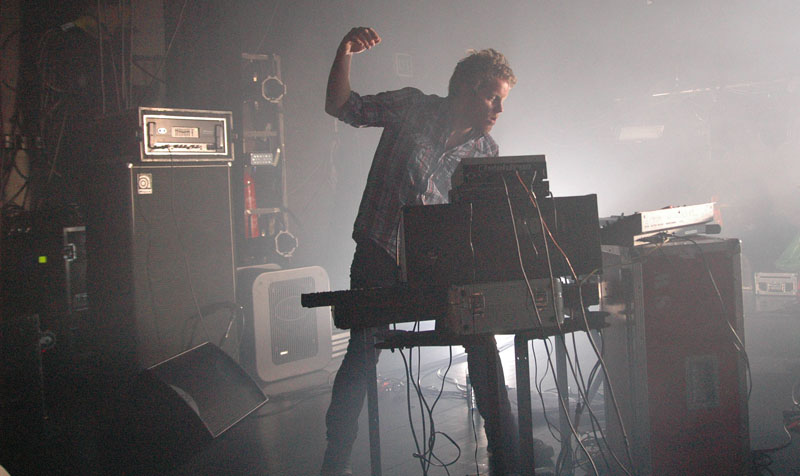
While there was a certain relentless nature to Puma's set, it also possessed a clear arc; a narrative that went from softer plateaus to ear-crunching heights, where communication was a fundamental, as Moen, Nilssen and Westerhus relied on eye contact to move from unexpected landscapes to those on Half Nelson Courtship. But even when the trio moved into familiar territory, its approach was always open-ended, with particular harmonics or melodies providing the context for even greater exploration, as on the inevitable build of "Hachioji Silk Blues."
The lighting was just as diverse. At times in almost complete darkness, a series of bright lights created near-blinding bursts that reflected the near-nuclear extremes of Puma's music, while periodic strobe-lighting added the curiously unsettled yet unerringly focused nature of the performance.
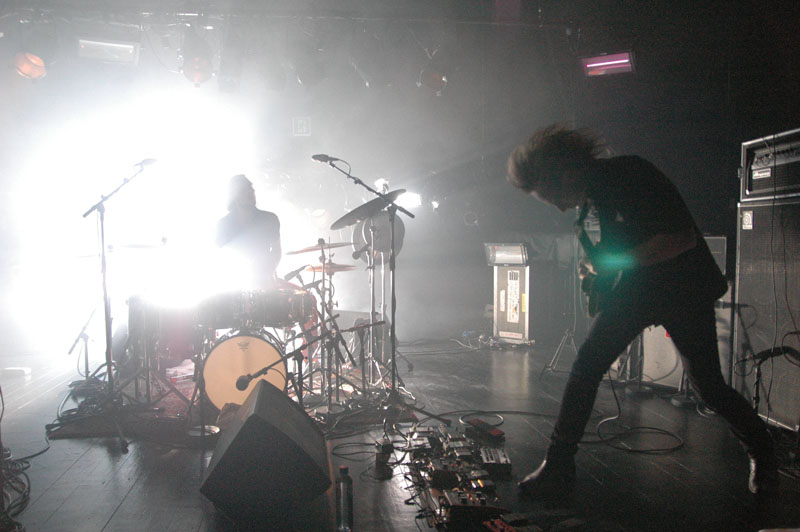
By the end of its late-night set, Puma was clearly exhausted but happy; a feeling shared by the audience, which clapped and screamed enthusiastically throughout the performance, but was so sated by its end that there was none of the usual screams and rhythmic clapping to call for an encore. It wasn't that Puma didn't deserve it; it was because—after 90-minutes of visceral, cathartic music that touched on a plethora of emotions and evoked plenty of abstract imagery—anything more would have been anti-climactic.
Coming Up: Molde Part 3, Rune Grammofon's Label in Residence series concludes with performances by Motorpsycho (a special event with Trondheim Jazz Orchestra, Trondheim Solistene and Sula Art Ensemble), Bushman's Revenge and Espen Eriksen, while label mate Stian Westerhus performs in duo with singer Sidsel Endresen. Also coming are performances by post-bop group The Core; a trio performance by guitarist Terje Rypdal, bassist Miroslav Vitous and drummer Gerald Cleaver; an early morning, Break of Day performance by Nils Petter Molvær with Biosphere; and the trumpeter's closing show, featuring guitarist Eivind Aarset, percussionist Adam Rudolph and Norwegian folksinger Sondre Bratland.
Photo Credits
All Photos: John Kelman
Part 1 | Part 2 | Part 3 | Part 4 | Part 5 | Part 6 | Part 7
< Previous
Don Aliquo: The Man, The Music, The J...
Next >
Rendez-Vous
Comments
Tags
Molde Jazz Festival
Live Reviews
John Kelman
Arild Andersen
Anja Lechner
andy sheppard
Eivind Aarset
Marilyn Mazur
Francois Couturier
Terje Rypdal
Miles Davis
Jan Garbarek
carla bley
Mathias Eick
Ola Kvernberg
Ingebrigt Haker Flaten
Håkon Kornstad
Joshua Redman
Supersilent
Robert Fripp
Jimi Hendrix
Jaga Jazzist
Zanussi Five
Bushman's Revenge
Motorpsycho
Bushman's Revenge
Espen Eriksen Trio
Sidsel Endresen
Terje Rypdal
Miroslav Vitous
Gerald Cleaver
Adam Rudolph
For the Love of Jazz
 All About Jazz has been a pillar of jazz since 1995, championing it as an art form and, more importantly, supporting the musicians who create it. Our enduring commitment has made "AAJ" one of the most culturally important websites of its kind, read by hundreds of thousands of fans, musicians and industry figures every month.
All About Jazz has been a pillar of jazz since 1995, championing it as an art form and, more importantly, supporting the musicians who create it. Our enduring commitment has made "AAJ" one of the most culturally important websites of its kind, read by hundreds of thousands of fans, musicians and industry figures every month.






















